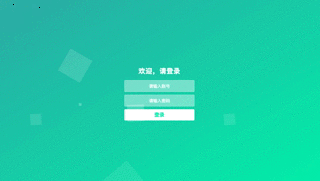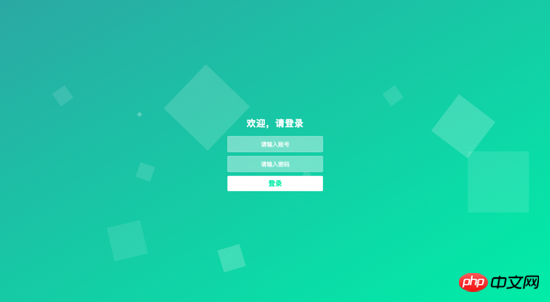CSS realizes dynamic bubble background code sharing
This article mainly introduces to you the relevant information on the method of realizing dynamic bubble background with CSS animation. The editor thinks it is quite good, so I will share it with you now and give it as a reference. Let’s follow the editor to take a look, I hope it can help everyone.
The first task today is to write a login page. The boss gave me a reference (chao) test (xi) case. You can see it by clicking the link. Well, this login page is indeed very concise and elegant, especially its bubble background. The first thought was that this should be a dynamic picture. After opening the review element, I discovered that it was written in code, which suddenly aroused the baby's curiosity. , so I also tried to write a login page with a bubble background. The effect is as follows:

emm...Why are the uploaded gif animations always so small? Screenshot:

#(You can imagine the picture of these background bubbles rising by yourself:sob:)
You can achieve it with just some simple codes For this effect,
First we define 10 li list tags. I use the vue framework:
<ul class="bg-bubbles">
<li v-for="(item, index) in bubbles" :key="index"></li>
</ul>created() {
this.bubbles.length = 10;
},The style is written in less:
.bg-bubbles {
position: absolute;
// 使气泡背景充满整个屏幕
top: 0;
left: 0;
width: 100%;
height: 100%;
li {
position: absolute;
// bottom 的设置是为了营造出气泡从页面底部冒出的效果;
bottom: -160px;
// 默认的气泡大小;
width: 40px;
height: 40px;
background-color: rgba(255, 255, 255, 0.15);
list-style: none;
// 使用自定义动画使气泡渐现、上升和翻滚;
animation: square 15s infinite;
transition-timing-function: linear;
// 分别设置每个气泡不同的位置、大小、透明度和速度,以显得有层次感;
&:nth-child(1) {
left: 10%;
}
&:nth-child(2) {
left: 20%;
width: 90px;
height: 90px;
animation-delay: 2s;
animation-duration: 7s;
}
&:nth-child(3) {
left: 25%;
animation-delay: 4s;
}
&:nth-child(4) {
left: 40%;
width: 60px;
height: 60px;
animation-duration: 8s;
background-color: rgba(255, 255, 255, 0.3);
}
&:nth-child(5) {
left: 70%;
}
&:nth-child(6) {
left: 80%;
width: 120px;
height: 120px;
animation-delay: 3s;
background-color: rgba(255, 255, 255, 0.2);
}
&:nth-child(7) {
left: 32%;
width: 160px;
height: 160px;
animation-delay: 2s;
}
&:nth-child(8) {
left: 55%;
width: 20px;
height: 20px;
animation-delay: 4s;
animation-duration: 15s;
}
&:nth-child(9) {
left: 25%;
width: 10px;
height: 10px;
animation-delay: 2s;
animation-duration: 12s;
background-color: rgba(255, 255, 255, 0.3);
}
&:nth-child(10) {
left: 85%;
width: 160px;
height: 160px;
animation-delay: 5s;
}
}
// 自定义 square 动画;
@keyframes square {
0% {
opacity: 0.5;
transform: translateY(0px) rotate(45deg);
}
25% {
opacity: 0.75;
transform: translateY(-400px) rotate(90deg)
}
50% {
opacity: 1;
transform: translateY(-600px) rotate(135deg);
}
100% {
opacity: 0;
transform: translateY(-1000px) rotate(180deg);
}
}
}At this point, a bubble background image is completed. Looking back, it is indeed not difficult, but more and more people feel the charm and power of CSS animation :relaxed:.
Related recommendations:
Photoshop CS5 Variety Brush Tutorial: Fantasy Bubble Background
How to use button trigger to achieve background color Flicker
CSS implementation of adaptive full-screen web page background image
The above is the detailed content of CSS realizes dynamic bubble background code sharing. For more information, please follow other related articles on the PHP Chinese website!

Hot AI Tools

Undresser.AI Undress
AI-powered app for creating realistic nude photos

AI Clothes Remover
Online AI tool for removing clothes from photos.

Undress AI Tool
Undress images for free

Clothoff.io
AI clothes remover

AI Hentai Generator
Generate AI Hentai for free.

Hot Article

Hot Tools

Notepad++7.3.1
Easy-to-use and free code editor

SublimeText3 Chinese version
Chinese version, very easy to use

Zend Studio 13.0.1
Powerful PHP integrated development environment

Dreamweaver CS6
Visual web development tools

SublimeText3 Mac version
God-level code editing software (SublimeText3)

Hot Topics
 1378
1378
 52
52
 How to write split lines on bootstrap
Apr 07, 2025 pm 03:12 PM
How to write split lines on bootstrap
Apr 07, 2025 pm 03:12 PM
There are two ways to create a Bootstrap split line: using the tag, which creates a horizontal split line. Use the CSS border property to create custom style split lines.
 How to insert pictures on bootstrap
Apr 07, 2025 pm 03:30 PM
How to insert pictures on bootstrap
Apr 07, 2025 pm 03:30 PM
There are several ways to insert images in Bootstrap: insert images directly, using the HTML img tag. With the Bootstrap image component, you can provide responsive images and more styles. Set the image size, use the img-fluid class to make the image adaptable. Set the border, using the img-bordered class. Set the rounded corners and use the img-rounded class. Set the shadow, use the shadow class. Resize and position the image, using CSS style. Using the background image, use the background-image CSS property.
 The Roles of HTML, CSS, and JavaScript: Core Responsibilities
Apr 08, 2025 pm 07:05 PM
The Roles of HTML, CSS, and JavaScript: Core Responsibilities
Apr 08, 2025 pm 07:05 PM
HTML defines the web structure, CSS is responsible for style and layout, and JavaScript gives dynamic interaction. The three perform their duties in web development and jointly build a colorful website.
 How to resize bootstrap
Apr 07, 2025 pm 03:18 PM
How to resize bootstrap
Apr 07, 2025 pm 03:18 PM
To adjust the size of elements in Bootstrap, you can use the dimension class, which includes: adjusting width: .col-, .w-, .mw-adjust height: .h-, .min-h-, .max-h-
 How to set up the framework for bootstrap
Apr 07, 2025 pm 03:27 PM
How to set up the framework for bootstrap
Apr 07, 2025 pm 03:27 PM
To set up the Bootstrap framework, you need to follow these steps: 1. Reference the Bootstrap file via CDN; 2. Download and host the file on your own server; 3. Include the Bootstrap file in HTML; 4. Compile Sass/Less as needed; 5. Import a custom file (optional). Once setup is complete, you can use Bootstrap's grid systems, components, and styles to create responsive websites and applications.
 How to use bootstrap in vue
Apr 07, 2025 pm 11:33 PM
How to use bootstrap in vue
Apr 07, 2025 pm 11:33 PM
Using Bootstrap in Vue.js is divided into five steps: Install Bootstrap. Import Bootstrap in main.js. Use the Bootstrap component directly in the template. Optional: Custom style. Optional: Use plug-ins.
 How to use bootstrap button
Apr 07, 2025 pm 03:09 PM
How to use bootstrap button
Apr 07, 2025 pm 03:09 PM
How to use the Bootstrap button? Introduce Bootstrap CSS to create button elements and add Bootstrap button class to add button text
 How to view the date of bootstrap
Apr 07, 2025 pm 03:03 PM
How to view the date of bootstrap
Apr 07, 2025 pm 03:03 PM
Answer: You can use the date picker component of Bootstrap to view dates in the page. Steps: Introduce the Bootstrap framework. Create a date selector input box in HTML. Bootstrap will automatically add styles to the selector. Use JavaScript to get the selected date.




